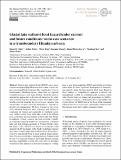Glacial lake outburst flood hazard under current and future conditions : worst-case scenarios in a transboundary Himalayan basin
Abstract
Glacial lake outburst floods (GLOFs) are a major concern throughout High Mountain Asia, where societal impacts can extend far downstream. This is particularly true for transboundary Himalayan basins, where risks are expected to further increase as new lakes develop. Given the need for anticipatory approaches to disaster risk reduction, this study aims to demonstrate how the threat from a future lake can be feasibly assessed alongside that of worst-case scenarios from current lakes, as well as how this information is relevant for disaster risk management. We have focused on two previously identified dangerous lakes (Galongco and Jialongco), comparing the timing and magnitude of simulated worstcase outburst events from these lakes both in the Tibetan town of Nyalam and downstream at the border with Nepal. In addition, a future scenario has been assessed, whereby an avalanche-triggered GLOF was simulated for a potential large new lake forming upstream of Nyalam. Results show that large (> 20 × 106 m3 ) rock and/or ice avalanches could generate GLOF discharges at the border with Nepal that are more than 15 times larger than what has been observed previously or anticipated based on more gradual breach simulations. For all assessed lakes, warning times in Nyalam would be only 5–11 min and 30 min at the border. Recent remedial measures undertaken to lower the water level at Jialongco would have little influence on downstream impacts resulting from a very large-magnitude GLOF, particularly in Nyalam where there has been significant development of infrastructure directly within the high-intensity flood zone. Based on these findings, a comprehensive approach to disaster risk management is called for, combining early warning systems with effective land use zoning and programmes to build local response capacities. Such approaches would address the current drivers of GLOF risk in the basin while remaining robust in the face of worst-case, catastrophic outburst events that become more likely under a warming climate.
Citation
Allen , S K , Sattar , A , King , O , Zhang , G , Bhattacharya , A , Yao , T & Bolch , T 2022 , ' Glacial lake outburst flood hazard under current and future conditions : worst-case scenarios in a transboundary Himalayan basin ' , Natural Hazards and Earth System Sciences , vol. 22 , no. 11 , pp. 3765-3785 . https://doi.org/10.5194/nhess-22-3765-2022
Publication
Natural Hazards and Earth System Sciences
Status
Peer reviewed
ISSN
1561-8633Type
Journal article
Description
Funding: This research has been supported by the Swiss National Science Foundation (grant no. IZLCZ2_169979/1) and by the Strategic Priority Research Program of the Chinese Academy of Sciences (grant no. XDA20100300).Collections
Items in the St Andrews Research Repository are protected by copyright, with all rights reserved, unless otherwise indicated.

